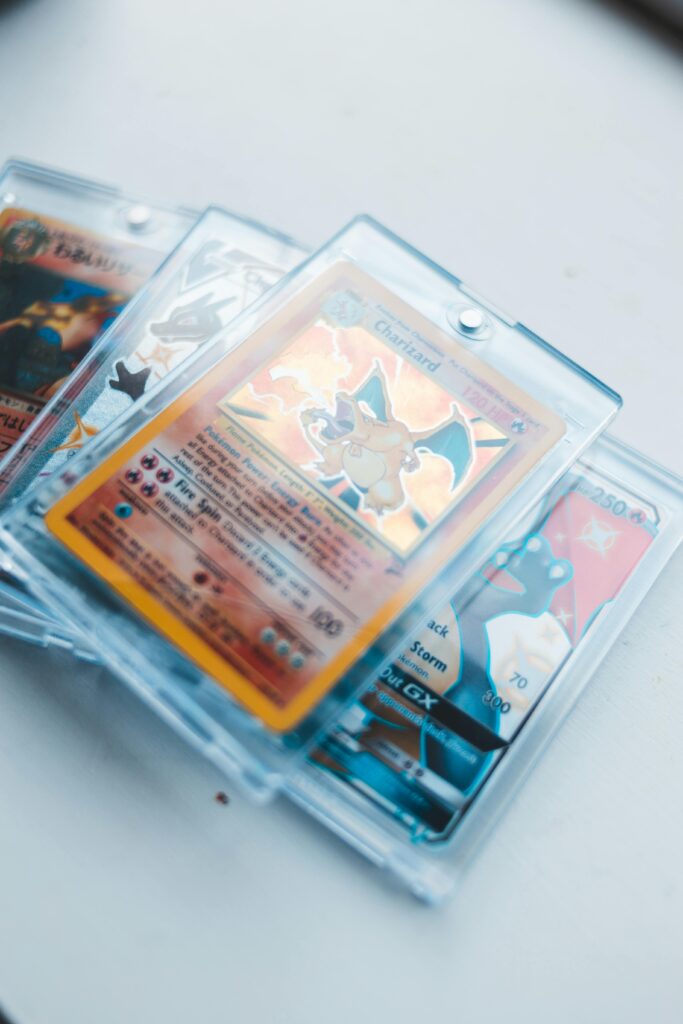From Near Mint to Damaged – How Condition Impacts Value, Rarity, and Collectability
In the world of Pokémon collecting, condition is king. You could be holding a rare Base Set Charizard or a dazzling modern Alt Art — but if the edges are worn or the holo is scratched, it might not be worth nearly what you think.
Whether you’re buying, selling, or just organizing your collection, understanding how card condition works is crucial to making smart decisions.
In this guide, we’ll break down the most common condition grades — from Near Mint to Damaged — and explain how each affects the card’s value, collectability, and long-term investment potential.
🎯 Why Condition Matters
Let’s get this out of the way: condition has a direct impact on a card’s price.
- A Near Mint card might sell for $200
- The same card in Moderate Play might only fetch $90
- In Damaged condition? Maybe $30 or less
Collectors and investors always want the cleanest, highest-grade version of any card. Whether you’re submitting for grading, selling raw, or just curating a collection — the condition tells the story.
🔍 Card Condition Scale Breakdown
Most collectors and sellers (especially on platforms like TCGPlayer, eBay, and Whatnot) use a common condition scale:
🌟 Near Mint (NM)
What It Means:
- Cards are almost flawless.
- May have tiny edge wear or a microscopic nick, but no major flaws.
- Clean front, clean back, excellent centering.
Visual Signs:
- Glossy surface
- Sharp corners
- No scratches, bends, or whitening
- Barely touched
Value Impact:
This is the gold standard for raw cards. Near Mint cards command top dollar and are often what buyers look for when adding to binders or preparing for grading.
👍 Lightly Played (LP)
What It Means:
- Minor wear, but still a solid display card.
- Small whitening, tiny surface scratch, or faint edge wear.
- Card retains strong visual appeal.
Visual Signs:
- Slight edge/corner wear
- Mild holo scratching (not deep)
- Light shuffle wear
Value Impact:
Usually sells for 10–20% less than Near Mint. Still desirable, especially for binder collectors or casual players.
⚖️ Moderately Played (MP)
What It Means:
- Visible wear from regular play.
- Card has clearly been used but not abused.
- Surface scratches, heavier edge whitening, or slight creasing may be present.
Visual Signs:
- Multiple whitening spots
- Moderate scratches or light creases
- Slight bend or warp
Value Impact:
Typically sells for 30–50% of Near Mint value. Less appealing to high-end collectors but great for players or budget buyers.
🛑 Heavily Played (HP)
What It Means:
- Card shows major signs of wear
- Not suitable for grading or serious collecting, but might still be legal for play (with sleeves).
Visual Signs:
- Deep scratches
- Major edge or corner whitening
- Large bends or creases
- Possible dirt or grime
Value Impact:
Only the rarest of cards hold value in this condition. Expect 60–80% depreciation vs. NM condition.
💔 Damaged
What It Means:
- Serious structural flaws.
- Creases, rips, water damage, writing, heavy grime, or missing pieces.
Visual Signs:
- Obvious tears or holes
- Ink stains or water marks
- Crumpled or warped
- Illegible surface
Value Impact:
Usually has minimal to no value unless the card is extremely rare or sentimental. Some damaged vintage cards are still purchased by collectors for display or “rescue.”
💡 Condition Comparison Chart
| Condition | Ideal For | Key Flaws | Value Retained |
|---|---|---|---|
| Near Mint (NM) | Grading, Collectors | None to tiny flaws | 90–100% |
| Light Play (LP) | Binders, Trades | Small edge wear/scratch | 75–90% |
| Moderate Play (MP) | Budget Builds | Visible wear, minor creases | 50–70% |
| Heavily Played (HP) | Play Decks, Proxy | Major wear, scratches | 20–40% |
| Damaged | Display only, nostalgia | Rips, tears, stains | <20% |
📸 Want to See Real-Life Examples?
We recommend looking at comparison photos on TCGPlayer’s condition guide, Reddit’s r/pkmntcgcollections, or grading companies like PSA or CGC to study how flaws are judged.
Would you like us to create a visual condition guide graphic you can use in your blog or Instagram? Just say the word!
🧠 Pro Tips for Card Condition Accuracy
- Always use good lighting when checking cards
- Compare the front AND back – many collectors forget to check both sides
- Use soft sleeves and top loaders to avoid condition damage when storing or mailing
- When selling, always under-promise and over-deliver — it’s better to label an LP card and let the buyer be pleasantly surprised than to risk a return from overrating
🏁 Final Thoughts: Condition Isn’t Everything — But It’s Close
Whether you’re hunting for a childhood grail or investing in long-term value, condition is one of the most important factors in determining a card’s place in your collection — and its place on the market.
It’s okay to collect cards in any condition that brings you joy. A Heavily Played Blastoise from your first deck may mean more than a PSA 10 Alt Art you pulled last week. But when it comes to value, rarity, and trade leverage — the cleaner, the better.
